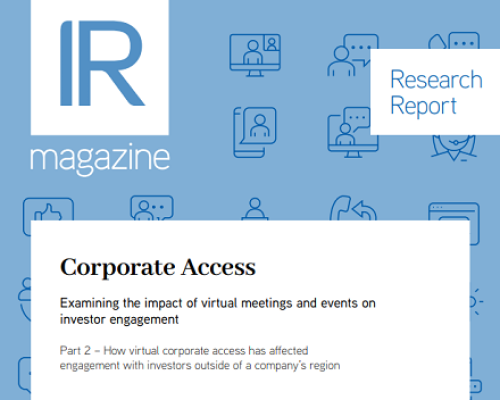In mid-March, British Telecom’s (BT) IR team was getting ready for Citigroup’s Communications Services Conference. The week before the event, around the time the IR team would normally be drafting remarks, BT’s CEO Philip Jansen announced that he had tested positive for Covid-19 and was self-isolating. In a sign of what was to come, Jansen agreed to participate in the event virtually, dialing in from the comfort and safety of his own home, while nursing a fever.
After people muddled through events in early to mid-March by tapping elbows instead of shaking hands, repeatedly applying hand sanitizer and looking suspiciously at the lunch buffet, many sell-side conferences were canceled, postponed or converted to virtual events. Company travel bans were imposed and people quickly adjusted to working remotely. The disruption was huge and unprecedented – one company executive was en route to the airport when he was notified at 5.00 am that his planned marketing trip was being canceled due to a company-wide travel ban.
As of late April, most sell-side conferences are being delivered virtually until at least the end of June. Privately, several corporate access professionals have told IR Magazine that they are preparing to host virtual events all the way through until September, but negotiations with event venues and uncertainty about what the next phase of the Covid-19 response will look like mean announcements aren’t being made. Complications arise from the need to balance a busy events calendar during the second half of the year with lingering concerns about a potential second wave of Covid-19 infections.
The sell-side pivot
Many corporate access teams on the sell side have hosted virtual events and meetings in the past, but there was a feeling that they didn’t offer the same quality of interaction as in-person meetings. During this forced period of virtual corporate access, this view is softening slightly. It remains to be seen whether interpersonal cues – such as body language – convert effectively to a virtual format. One corporate access professional tells IR Magazine that it’s hard to compare because the contexts are so different: an executive’s body language could be very different on stage in front of hundreds of people compared with in his or her home office in front of a webcam (and potentially with a pet or child making an appearance).
For Mike O’Connor, global head of access strategies at Citigroup, Covid-19 has accelerated – rather than initiated – his adoption of virtual events. Speaking at an IR Magazine virtual event in early April, O’Connor explained that his team first started using virtual meetings in 2016, organizing 4,000 of them. In 2017 that grew to 10,000, in 2018 to 17,000 and last year the team organized 30,000 virtual meetings.
‘Our initial idea was that the demand for meetings between corporates and investors would be higher if the meetings could be done on a more timely basis,’ O’Connor said at the time. ‘We developed the concept from there, adding in virtual elements to existing physical events, and then we started doing small virtual-only events.’
This is an extract from an article that appeared in the Summer 2020 issue of IR Magazine. To continue reading, click here to open the full digital edition of IR Magazine










